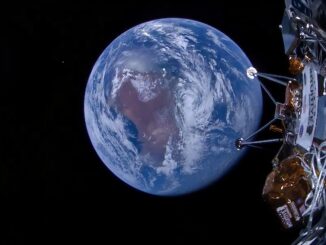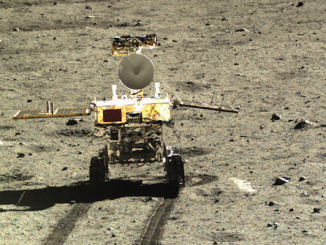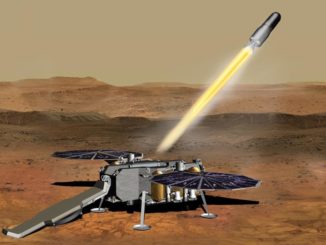
India’s first lunar lander has been hoisted on top of its GSLV Mk.3 rocket ahead of a liftoff scheduled for Sunday.
The launch aboard India’s most powerful rocket — the Geosynchronous Satellite Launch Vehicle Mk.3 — will begin a nearly two-month cruise through ever-higher orbits around Earth, and ultimately into lunar orbit before commencing a powered descent to the moon’s surface Sept. 6.
The Chandrayaan 2 mission consists of three components — an orbiter module, landing craft and mobile rover — launching together on the GSLV Mk.3 from the Satish Dhawan Space Center on India’s southeast coast, the country’s sole spaceport on Sriharikota Island around 50 miles (80 kilometers) north of Chennai.
Liftoff is set for 2121 GMT (5:21 p.m. EDT) Sunday, and the GSLV Mk.3 will place the Chandrayaan 2 spacecraft into an elliptical transfer orbit stretching some 25,100 miles (40,400 kilometers) above Earth.
The launch is scheduled for 2:51 a.m. Monday local time in India.
“The Chandrayaan 2 mission contains three components, that is the rover, which is only 27 kilograms (59 pounds), and we have a lander that’s 1.4 tonnes (3,100 pounds),” said K. Sivan, chairman of the Indian Space Research Organization. “This rover is kept inside the lander, and the lander is kept on an orbiter. The orbiter is 2.4 tonnes (5,300 pounds).
“The total composite module has a mass of about 3.8 tonnes (8,400 pounds),” Sivan said.

Chandrayaan 2 is India’s first lunar landing mission, and the country’s second robotic mission to the moon following the launch of the Chandrayaan 1 orbiter in October 2008.
The launch Sunday will come two days before the 50th anniversary of the launch of Apollo 11.
If the landing is successful, India will become the fourth nation to accomplish a controlled soft landing on the moon, after the former Soviet Union, the United States and China. The Israeli non-profit SpaceIL attempted a landing on the moon in April with the Beresheet mission, but the privately-funded probe crashed on final descent.
Located at approximately 71 degrees south latitude, Chandrayaan 2’s target landing site is closer to the moon’s south pole than any previous mission, roughly 220 miles (350 kilometers) from the rim of the South Pole-Aitken basin.
Scientists believe he sprawling basin region is one of the most ancient impact sites in the solar system, created when a large asteroid or comet struck the moon billions of years ago.
For the first time, Chandrayaan 2’s rover could examine ancient material in the lunar crust ejected during the colossal collision that created the South Pole-Aitken basin, providing data that could yield clues about the solar system’s chaotic early history. The rover, named Pragyan, carries an alpha particle X-ray spectrometer to measure the elemental composition of the rocks at the Chandrayaan 2 landing site, along with a laser-induced breakdown spectroscope.

China accomplished the first soft landing on the far side of the moon in January in the mid-latitudes of the southern hemisphere, within the South Pole-Aitken basin. The Chang’e 4 mission’s stationary lander and rover are still operational.
But Chang’e 4 did not carry an X-ray spectrometer to obtain elemental measurements of the lunar crust. The presence of such an instrument on-board Chandrayaan 2 could be boon for lunar geologists.
Five science payloads will each operate on the Chandrayaan 2 lander, dubbed Vikram, and the mission’s orbiter component. The instruments include spectrometers, radars, plasma sensors and cameras.
The Chandrayaan 2 landing craft also carries a passive laser retro-reflector provided by NASA to allow precise measurements between the Earth and the moon, and potentially become a node in a lunar navigation network to help guide future missions.
Chandrayaan 2’s orbiter and lander segments arrived at the launch base in mid-June from the U.R. Rao Satellite Center in Bengaluru. On June 29, ground crews at the launch site integrated the rover with the landing craft, then stacked the lander on top of the orbiter module.
Technicians conducted radio frequency checks with the Chandrayaan 2 spacecraft July 2, and encapsulated the probe inside the GSLV Mk.3’s payload fairing, the rocket’s nose cone.

ISRO teams hoisted the Chandrayaan 2 spacecraft atop the GSLV Mk.3 rocket July 4, and the fully-assembled vehicle rolled out to the Second Launch Pad at Sriharikota on Sunday. The launch team held a mission dress rehearsal Monday, and technicians on Tuesday worked on the launcher’s pyrotechnic devices used for major launch and in-flight separation events.
The launch will mark the third orbital flight of India’s GSLV Mk.3, and the rocket’s first operational mission after two full-up test flights in 2017 and 2018.
Indian officials originally assigned the Chandrayaan 2 mission to fly on the smaller GSLV Mk.2 rocket, but the spacecraft’s weight grew during development, prompting managers last year to switch to the bigger launcher.
Email the author.
Follow Stephen Clark on Twitter: @StephenClark1.



